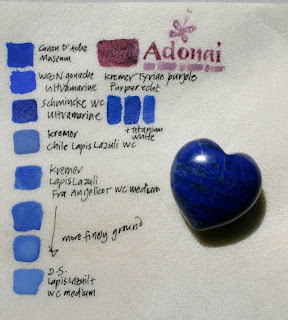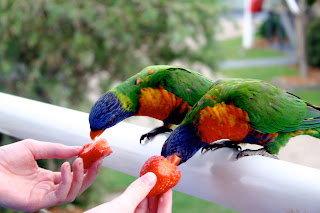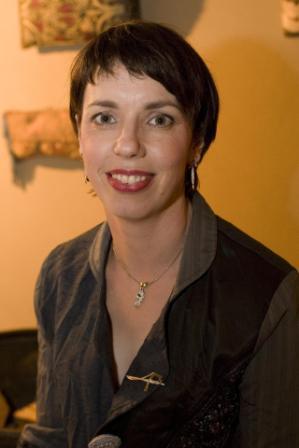Happy New Year to everyone.
 Veni Emmanuel Christmas 2007
Veni Emmanuel Christmas 2007 The year that has been, 2007, was a big challenge for me and a time of growth both professionally and personally. Most of my writing this year has been to meet the requirements of the university for my PhD. The year ahead, 2008, will begin with a holiday back in the beautiful Hokianga in the far north of New Zealand looking for pipis, blackberries, and some artistic inspiration, as well as enjoying time with the family. There are a number of interesting art and craft purveyors in the Far North so it will be a good opportunity to take a look as I take a break in the expectation of my third child being born toward the end of February.
My year has probably been fuller than ever, never a dull moment. I continued to take on calligraphy work as well as completing my first provisional year of PhD studies looking at occupational hazards of scribes and illuminators.
I am enjoying studying again, and fully appreciate what is now available to tertiary students via the internet and online library resources. It makes it feasible for me to study at home in the evenings using my computer, something that was impossible when I finished studying 18 years ago for my M.Sc. The computer seems much more familiar these days and my typing isn’t quite so atrocious. I even gave a powerpoint presentation (in Auckland) on my studies thus far in November to a panel of established Massey and AUT University supervisors, Auckland and Wellington based, for my first year assessment. It was very well received with a number of encouraging comments. With special thanks to Dr Rachel Page, Director in the School on Massey University's Wellington Campus for the special courtesy of penciling the meeting in.
 Working under an ultraviolet nightclub lamp at twilight
Working under an ultraviolet nightclub lamp at twilight I began the year with some very interesting work arriving in the studio including a real doozy from a big ad agency looking to impress its clients with a new range of Macleans toothpaste. I was asked to write 100 A4 letters in invisible ink! So I can hear you ask how is it done? Answer: in the dark under UV light, so I purchased a nightclub grade UV bulb and some safety goggles! We didn't need to use the forensic grade marker pens, little girls' standard diary pens were just fine and less expensive. It was a fun job to get, but just once I think. My husband uses the product though. Perhaps I will take a leaf out of Anne Geddes' book in 2008 and restrict accession to such requests to the the Moroccan royalty, King Mohammed VI and Princess Lalla Salma.
So how many of you have considered what “New Zealand” means literally? New Denmark of course. I have had some lovely correspondence earlier this year with a Danish calligrapher,
Lise Kirketerp. Our correspondence was not fluent in either Danish or English, but beautiful letters and a charming Danish website made for nice exchange. Lise knew of Peter Gilderdale, but had no idea he lived so far away in New Zealand! Peter has had the best selling Danish calligraphy text book “Kalligraphi: Kunsten at skrive smukt” for some years having been reprinted 3 times. The images of Lise’s studio look just adorable.
For those of you who have been looking for the results of my lightfastness test on some of the new Derwent coloursoft pencils, here they are.

To be fair to Derwent, I could only purchase them as a set of 12 in New Zealand, and looking at the lightfastness rating on their website, there are other coloured pencils in their range with higher lighfastness ratings in similar shades, if you were able to purchase them individually. For example, the bright lilac included in the 12 set has only a 2 rating (low lightfastness) while pale lavender has an 8 rating (high lightfastness). Their ratings seem to be accurate. It was suggested to me that spraying with studio fixative can improve the lightfastness, so the left hand band of the sample has been sprayed with studio fixative. It has made a slight difference with most of the pigments, but it does not significantly increase the lightfastness of those pigments with very limited lightfastness.

It was great to host Dave Wood over from Australia this year to teach traditional raised and burnished gilding. Pictured above with New Zealand Calligraphers' liaison officer for the northern city of Whangarei Bevan Holmes, Dave is a master calligrapher and gilder (a fellow of the Society of Scribes & Illuminators), with all his gold work finished to a mirror like shine. My effort at the workshop is pictured below.

The group that attended also had the advantage of viewing some of Dave’s recent work, including images of his large commissioned piece for the Queensland State Library, which is now permanently housed in display cases in the foyer of the library. Those of you attending the Chicago Calligraphy Conference next year might like to consider taking Dave’s class, I doubt that you would regret it.
I mentioned in a 2006 column for the New Zealand Calligraphers’ Newsletter that I particularly like the Foundational hand in the Purewa Cemetery memorial book that I work on which I have always thought to be an attractive feminine hand.
 Purewa Cemetery Memorial Book- the ruler markings on the left are in millimetres
Purewa Cemetery Memorial Book- the ruler markings on the left are in millimetres Chatting with Dave Wood recently I have found that he met the person whose writing I admired. Dave was formerly a New Zealand resident. Apparently she traveled to London and was a student at Edward Johnston’s old Central School for two years! So what is her name? The most information that I can get so far is that her Christian name was/is Margaret, and if she is still alive she would be in her 80’s. Her beautiful writing was all done with a quill. Let me know if you can fill in the story.
Susan Hopkins, from Santa Barbara, was a very welcome visitor in November. We enjoyed a day together working on various ruling pen and pointed pen styles as well as sharing stories and thoughts on illustrations, journaling, life, etc. It is remarkable how small the world can be, Susan having been referred to me by a friend on cyberscribes who knew that Susan was coming down under to follow the work of another New Zealand artist also. We had alot in common, Susan having spent her working life as an art teacher to deaf children and my husband now beginning to teach Massey University students audiology including introductory deaf education. I hope to get to Santa Barbara some time soon.
I have been studying the pigments that were used historically in manuscripts throughout this year. Here is a picture of me grinding lapis lazuli in September.

It is amazing the analytical research that has been done in the last 15 years or so, that has enabled us to know exactly what pigments were used at different places and at different times. However, it does not answer all my questions with regard to how they were manufactured and processed, and by whom.
 Modern and Traditional Pigment Samples on Vellum. You may have noticed the etching on a number of my samples- the native roaches have singular taste it appears!
Modern and Traditional Pigment Samples on Vellum. You may have noticed the etching on a number of my samples- the native roaches have singular taste it appears! Study has been an exciting adventure, with highs when you find a piece of information you have been trying to discover for some time, and lows when you don’t seem to be finding anything useful.
 Cheryl Porter and moi
Cheryl Porter and moi The culmination and highlight of the year’s work was having Cheryl Porter teach her “Inks and pigments in early manuscripts” lecture series and workshop in Auckland from the 3-7 of December at the Whitecliffe College of Fine Art, a private tertiary college.
 Whitecliffe College, Grafton Campus Auckland
Whitecliffe College, Grafton Campus Auckland Cheryl is a manuscript conservator whose interest in historical pigments has taken her on some amazing trips, such as the Armenian border in search of Armenian cochineal.
 Mexican Cochineal and Kermes- the ruler markings are in centimetres
Mexican Cochineal and Kermes- the ruler markings are in centimetres I had been in correspondence with Cheryl since the beginning of the year as she is a specialist in manuscript conservation and an authority on mediaeval pigments. Cheryl resides in England, though is originally from the backblocks of Western Australia, and works throughout the world. Cheryl’s next 3 year contract is at the museum in Cairo, Egypt.
Whitecliffe College is housed in some beautiful buildings built in the 1920’s, originally as a Theological College. Unfortunately, the art school is moving to new premises in the middle of 2008, apparently the buildings have been bought by Tom Cruise.
We had an interesting group of people attend who were all able to contribute their own particular skills and knowledge. It was well subscribed by librarians, art historians and interested individuals from Auckland and Dunedin, including Professor Stephanie Hollis from the University of Auckland. It was particularly interesting to have a session at Auckland City Library “Rare Book Room” examining three manuscripts which turned into a very insightful, interdisciplinary study. The Anglo-Saxon scholars provided information on the text, the book conservator on the binding, Cheryl provided information on the pigments, and the odd calligrapher added information on vellum and working practices.
 Cheryl Porter manufacturing Madder Lake
Cheryl Porter manufacturing Madder Lake So, what did I discover? First, that practically any pigment, such as vermilion, orpiment, ochre or woad, comes in a variety of shades. The colour is also altered by how finely the pigment might be ground and what binder has been used. We obviously couldn’t experiment with how colours might change over time, but this would also be a factor.
Secondly, I have an increased admiration of the skills required by scribes and illuminators in using some of these pigments so successfully, many of which are extremely difficult to use. For example, a bright azurite or malachite is so coarsely ground that it becomes extremely difficult to paint with and to get any sort of fine line with it. Similarly, sap green is extremely sticky to work with. Also, each pigment needs to be carefully prepared before you can start to paint, by grinding and combining with a binder. Some of the organic pigments after being collected and dried, must be warmed in water and then various additives such as alum and/or potassium carbonate added to produce a lake pigment.
We painted out a variety of pigments from the medieval palette over the five days; earth pigments, natural minerals, manufactured minerals, inks, and organic colours; the pigment samples that I painted can be seen in the images. Just don't spill the oak gall ink (metallo-gallic ink) on your sandstone floors!

We also had a go at painting some alum tawed skin using organic colours, which was the traditional book covering material used in the medieval period. It is a lovely thick, soft and flexible white skin that was also used to make gloves, which can be transformed into brilliantly coloured book coverings. I have become a member of the International Council of Museums (ICOM) on Cheryl’s advice and have already found their correspondence to be very rewarding.
On another not quite so old note, I was asked to participate in my daughter Shelley’s school “Victorian Day”, endeavoring to teach Victorian writing, that is copperplate, to 40 7-9 year olds. We were all rather covered in ink and I lost about 20 nibs but really enjoyed a precious opportunity to introduce another generation to the delights of calligraphy.
I recently had some extended correspondence on cyberscribes with a number of members including Séamus who pointed me in the direction of some online advice on woad. So prior to Cheryl’s visit and after some online searching I found an interesting French boutique and art material supplier
Bleu de Lectoure. So this Christmas I had a number of authentic woad items under the tree including a lovely scarf, some ink, pigment and watercolour. Apparently they may be supplying Levi Strauss nowadays with their historic dye which is now cropped more sustainably and processed more efficiently.
I have to say I have enjoyed reading some historical books this year which I thought would bore me silly. Humanity, and history, is just fascinating of course, and to find someone’s thoughts that you can wholeheartedly agree with, even though they may have lived hundreds of years ago, is amazing. I have even read much of Layamon’s Brut, a middle English recount of King Arthur that was very special to C.S Lewis towards the end of his life. But that’s a story for another time. Pliny the Elder’s “Natural History” Book 33 (AD 70), begins with his thoughts on humanity’s strange relationship with nature in search of metals:
“We trace out all the fibres of the earth, and live above the hollows we have made in her, marvelling that occasionally she gapes open or begins to tremble – as if forsooth it were not possible that this may be an expression of indignation of our holy parent! We penetrate her inner parts and seek for riches in the abode of the spirits of the departed, as though the part where we tread upon her were not sufficiently bounteous and fertile. And amid all this the smallest object of our searching is for the sake of remedies for illness, for with what fraction of mankind is medicine the object of this delving?”
I also delighted to read the 1573 English treatise “The Arte of Limming” as much for the language as for the information. I am now enjoying Nicholas Hilliard’s “Art of Limning” for much the same reasons, and to discover an artist far more pedantic than me! Hilliard painted delightful and extremely delicate miniature portraits of Queen Elizabeth I, Sir Walter Raleigh and the like, so I guess he had even more reason to take care.
Below is some doodling using some "new" antique ruling pens that I received for Christmas and a range of commercially available watercolours, mostly Schmincke. My old faithful ebony ruling pen is joined here by a bone handled, smaller pen and two larger ivory handled ruling pens one of which has been gold plated. The gold plated one is my favourite so far.
 The new ivory and bone handled additions to my antique ruling pen collection - Happy New Year!
The new ivory and bone handled additions to my antique ruling pen collection - Happy New Year! Wishing my readers all a very happy new year.
Regards,
Alison.
PS Congratulations to Akiho Sugiyama- now where are you Akiho?


































































